Bank Advice Letter
Subject: Bank Advice Letter
Dear [Bank Representative's Name],
I hope this letter finds you well. I am writing to seek your expert advice regarding my financial situation and potential banking services that would suit my needs.
Over the past few years, I have been diligently saving and managing my finances to secure a stable financial future for myself and my family. However, as my financial goals have evolved, I feel it is the right time to explore more suitable banking options and investment opportunities.
I am interested in discussing the following aspects with you:
1. **Savings and Investment Opportunities:** I am looking for long-term investment options that offer competitive returns while considering my risk appetite and financial goals. I would appreciate your guidance on various investment products offered by the bank, such as fixed deposits, mutual funds, or any other relevant options.
2. **Mortgage or Loan Options:** In the near future, I plan to purchase a new home, and I would like to learn about the mortgage options available. I am particularly interested in understanding the interest rates, repayment terms, and eligibility criteria for obtaining a mortgage or any other loan that may be beneficial for my situation.
3. **Retirement Planning:** As retirement planning is a crucial aspect of financial security, I would like to explore retirement account options and other financial instruments that can assist me in building a solid retirement corpus.
4. **Digital Banking Services:** I am also keen on exploring the bank's digital banking services, including online banking, mobile banking apps, and other technological advancements that can simplify and enhance my banking experience.
Given your expertise and experience in the banking industry, I trust that your advice will help me make well-informed decisions and pave the way for a stronger financial future. If possible, I would like to schedule a meeting with you at your earliest convenience to discuss these matters in detail.
Please let me know your availability so we can coordinate a suitable time to meet. Alternatively, if you prefer to communicate through email or over the phone, I am more than willing to accommodate your preference.
Thank you for your time and attention to my request. I eagerly look forward to your guidance and expertise. Should you need any additional information, please feel free to reach me at [Your Phone Number] or [Your Email Address].
Sincerely,
[Your Name]
Formal Bank Advice Letter for Payment
Subject: Bank Advice Regarding Payment
Dear [Recipient Name],
We would like to inform you that a payment of [Amount] has been successfully processed to your account [Account Number] on [Date]. This advice serves as confirmation of the transaction.
Please review the transaction details and notify us if there are any discrepancies. Your prompt acknowledgment will be appreciated.
Sincerely,
[Bank Name]
[Branch/Department]
Provisional Bank Advice Letter
Subject: Preliminary Bank Advice
Dear [Recipient Name],
This is to notify you that a transaction of [Amount] to your account [Account Number] is being processed and is expected to be completed by [Expected Date]. Please consider this advice as provisional until confirmation.
We appreciate your patience and understanding.
Best regards,
[Bank Name]
[Department]
Informal Bank Advice Email
Subject: Payment Update
Hi [Recipient Name],
Just a quick note to let you know that [Amount] has been credited to your account [Account Number] on [Date]. Please check your account and confirm receipt.
Thanks,
[Bank Name]
Bank Advice Letter for Fund Transfer Confirmation
Subject: Fund Transfer Confirmation
Dear [Recipient Name],
We hereby confirm that an amount of [Amount] has been transferred from your account [Sender Account Number] to [Beneficiary Name] on [Date]. Kindly find the transaction reference [Reference Number] for your records.
Should you have any questions regarding this transfer, please contact our customer service.
Sincerely,
[Bank Name]
[Department]
Heartfelt Bank Advice Letter
Subject: Payment Advice Notification
Dear Valued Client,
We are pleased to inform you that your requested transaction of [Amount] has been successfully completed to your account [Account Number] on [Date]. Thank you for choosing [Bank Name] for your banking needs.
Please contact us if there are any questions or clarifications needed. We value your trust and business.
Warm regards,
[Bank Name]
[Branch Manager]
Quick Bank Advice Message
Subject: Transaction Update
Dear [Recipient Name],
Your payment of [Amount] has been processed successfully on [Date]. Ref: [Reference Number].
Regards,
[Bank Name]
What is a Bank Advice Letter and Why You Need It
A bank advice letter is a formal or informal communication from a bank to a client or another financial entity to inform them of a transaction or financial action. The purpose of the letter is to:
- Notify the recipient of completed, pending, or scheduled transactions.
- Provide proof or acknowledgment of payments or fund transfers.
- Serve as a record for auditing or reconciliation purposes.
- Clarify details and avoid misunderstandings between parties. It is a key communication tool in banking operations to ensure transparency and accountability.
Who Should Send a Bank Advice Letter
- Bank officials such as branch managers, account officers, or customer service representatives.
- Authorized personnel in corporate banking or treasury departments.
- Digital banking system automatically generating email or message advice.
- Any designated contact responsible for client communications. The sender should be credible and authorized to issue financial advice.
Whom the Bank Advice Letter Should Be Addressed To
- Account holders (individuals or corporate clients).
- Beneficiaries of transactions.
- Third-party financial institutions involved in the transfer.
- Internal departments for reconciliation purposes. Addressing the correct recipient ensures clarity and proper record-keeping.
When to Send a Bank Advice Letter
- After a payment has been successfully processed.
- When a transaction is pending or provisional.
- To confirm receipt of funds in the beneficiary account.
- In response to client requests for transaction verification.
- As part of regular account statements or monthly updates. Timely sending ensures trust and operational transparency.
How to Write and Send a Bank Advice Letter
- Include a clear subject line referencing the transaction or advice.
- Address the letter appropriately (formal greeting or email salutation).
- State the transaction details: amount, account numbers, date, reference number.
- Clarify the status (completed, pending, provisional).
- Provide contact information for inquiries or follow-ups.
- Send via official channels: printed letter, secure email, or banking portal.
- Ensure professional and unambiguous language.
Requirements and Prerequisites Before Sending a Bank Advice Letter
- Confirm transaction details and correctness (amount, accounts, date).
- Verify authorization for issuing advice to the recipient.
- Check internal banking policies for communication format and approvals.
- Ensure confidentiality and security measures are in place.
- Prepare reference numbers, receipts, or supporting documents if necessary.
Formatting a Bank Advice Letter
- Length: 100–300 words depending on complexity of the transaction.
- Tone: Professional, clear, and courteous.
- Style: Formal for official letters; concise for email or digital messages.
- Structure: Subject, greeting, transaction details, action or confirmation, closing, signature.
- Mode: Printed letter, PDF attachment, email, or secure banking portal message.
- Etiquette: Polite and precise language; avoid ambiguity.
After Sending / Follow-up
- Confirm that the recipient has received and acknowledged the advice.
- Address any queries or discrepancies immediately.
- Update internal records and reconcile accounts accordingly.
- Maintain copies of the advice for auditing and compliance purposes.
- Send reminders for pending or provisional transactions if needed.
Common Mistakes to Avoid in Bank Advice Letters
- Sending incorrect or incomplete transaction details.
- Using informal or ambiguous language in formal letters.
- Failing to include reference numbers or critical identifiers.
- Sending advice to unauthorized recipients.
- Omitting contact information for follow-up or clarification.
- Delaying communication beyond an acceptable time frame.
Elements and Structure of a Bank Advice Letter
- Subject Line: Clearly indicates the purpose (e.g., Payment Advice, Fund Transfer Confirmation).
- Greeting: Properly addressing the recipient.
- Transaction Details: Amount, account numbers, date, reference number.
- Status Clarification: Completed, pending, or provisional.
- Additional Information: Contact details, instructions, or disclaimers.
- Closing Statement: Polite sign-off and appreciation if appropriate.
- Signature: Bank official, department, or automated system.
- Attachments (if necessary): Receipts, transaction confirmation, or supporting documents.
Tips and Best Practices for Bank Advice Letters
- Verify all transaction details before sending.
- Use a clear and concise format for easy understanding.
- Ensure security and confidentiality in communication.
- Include reference numbers and identifiers for accountability.
- Customize the tone depending on the recipient (formal or brief).
- Provide contact information for any queries.
- Maintain records of all sent advice letters for future reference.
Compare and Contrast Bank Advice Letters with Account Statements
- Bank advice letters notify about specific transactions; account statements provide a summary of all transactions over a period.
- Advice letters can be immediate and individual; statements are periodic.
- Advice letters require confirmation or acknowledgment; statements are informational.
- Both serve as official banking documentation and support financial record-keeping.

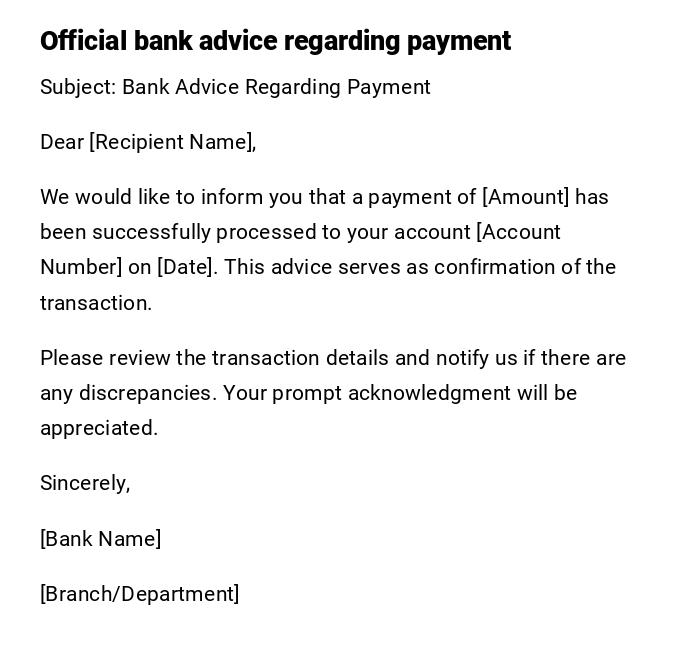
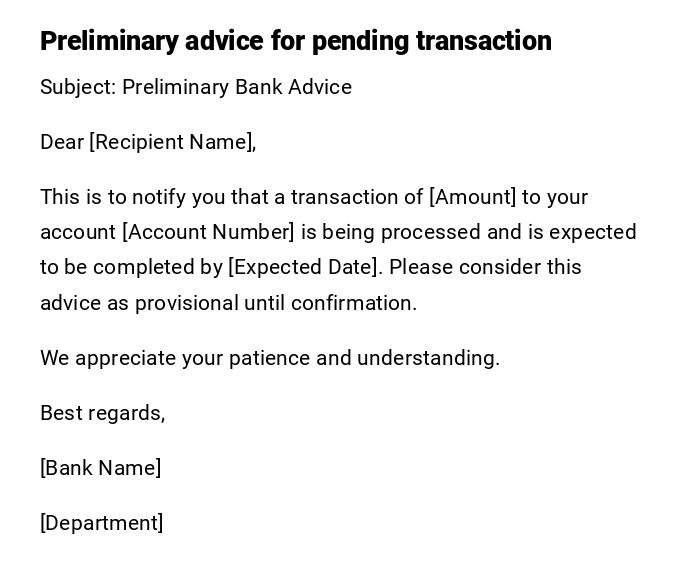
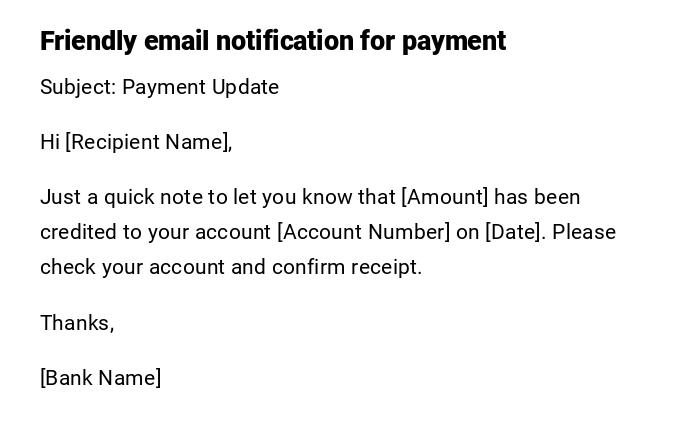
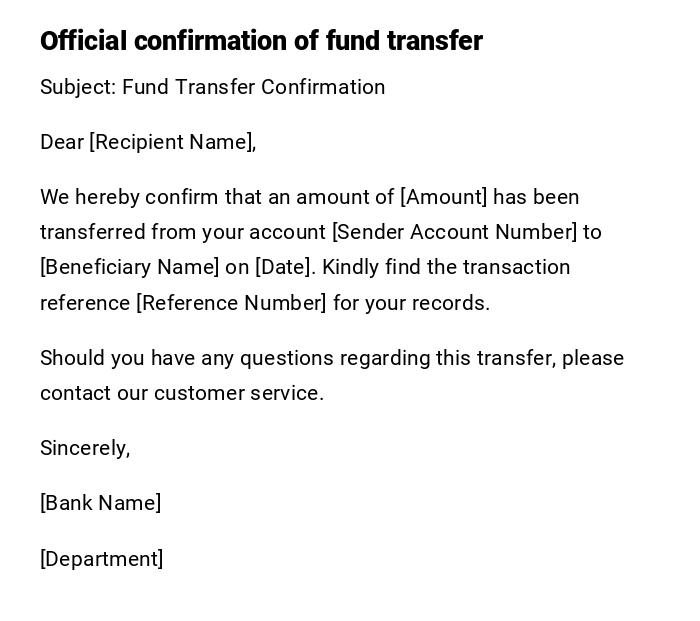
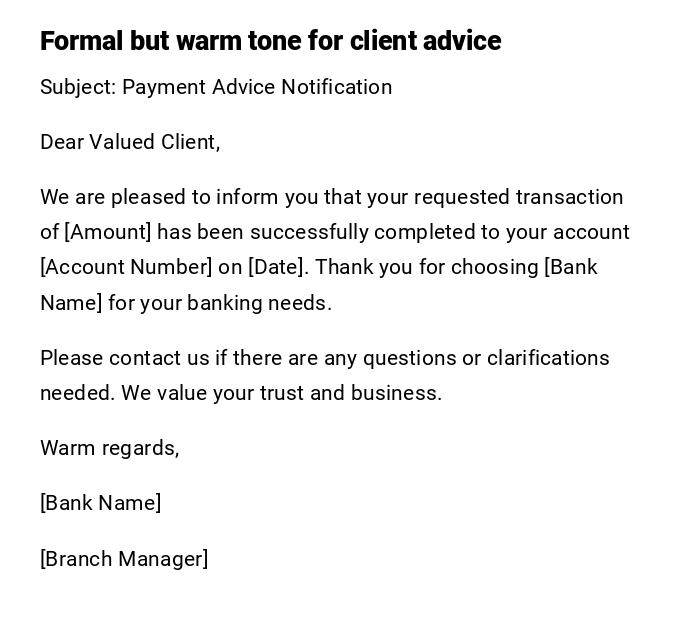
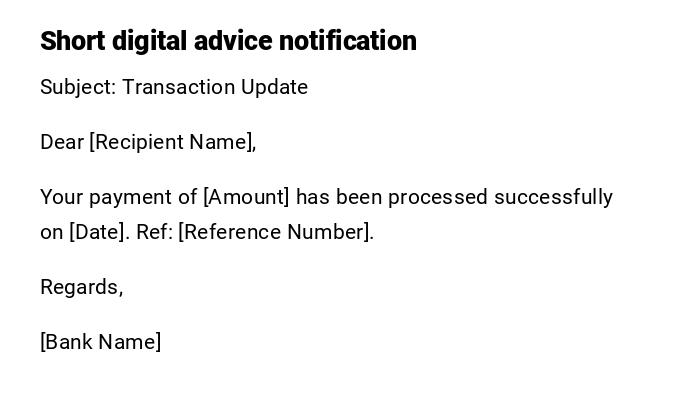

 Download Word Doc
Download Word Doc
 Download PDF
Download PDF